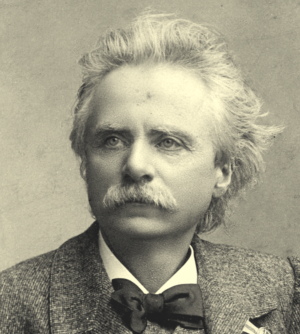 Among the most popular and successful of Edvard Grieg’s compositions are undoubtedly his “Lyric Pieces” for piano, published between 1867 and 1901 in ten separate volumes and ultimately combined into one complete volume in 1902. Yet though the editions were already reprinted thousands of times during his lifetime, many errors and oddities still remain unaltered to this day…
Among the most popular and successful of Edvard Grieg’s compositions are undoubtedly his “Lyric Pieces” for piano, published between 1867 and 1901 in ten separate volumes and ultimately combined into one complete volume in 1902. Yet though the editions were already reprinted thousands of times during his lifetime, many errors and oddities still remain unaltered to this day…
Now, it’s finally come to an end: after intensive source research and editorial work the complete volume is appearing in the autumn with all of the “Lyric Pieces” (HN 1136). For this our editors Einar Steen-Nøkleberg and Ernst-Günter Heinemann could evaluate for the first time several autographs and sketches still not accessible in the 1970s for the Grieg Complete Edition. The numerous inquiries we’ve received from customers and dealers show us that the new Henle edition is being eagerly awaited. And as a matter of fact it has been worth the effort, for although Grieg thoroughly proofread the first prints of his works and his Leipzig publisher C. F. Peters had them engraved with great care, yet one or the other printing error crept into the “Lyric Pieces”.
So, for instance, in the third piece in volume X, op. 71 – the same hobgoblin [Kobold] that served as namesake for this piece probably played a prank on the composer. In both hands of measure 16 the final note reads c flat in the print, in keeping with the key signature:
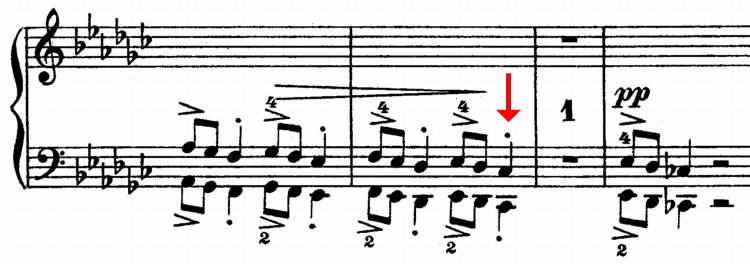
“Kobold”, op. 71 no. 3, measures 15–18
But, of course, every pianist is startled when two measures later there is explicitly a cautionary accidental before the c flat – was then c meant, however, in m. 16? At the end of the piece the passage appears once again, this time up a fourth, and confirms this supposition:
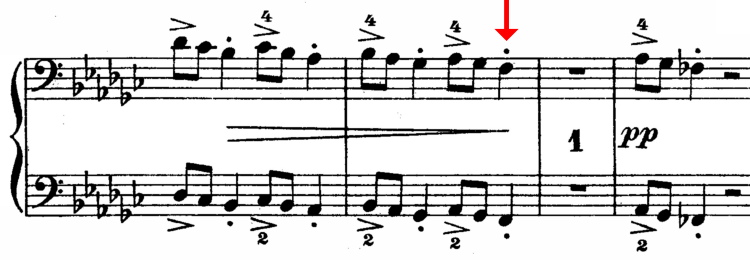
“Kobold” op. 71 no. 3, measures 74–77
The autograph, where Grieg has actually notated the natural signs correctly in m. 16 (to be seen in the digital Grieg-Collection of the Bergen Library), makes it absolutely certain. Only further in the course of publication did the accidentals then “toddle off”… In our edition this oversight is of course corrected and saves the musician from having to wonder, leaf back and forth and make the correction.
Less clear, on the other hand, are the accidentals at another spot. In the lively middle section of “Entschwundene Tage” [Vanished Days], the first piece of the 6th volume op. 57, there is a dramatic rise leading to a chord full of suspense:
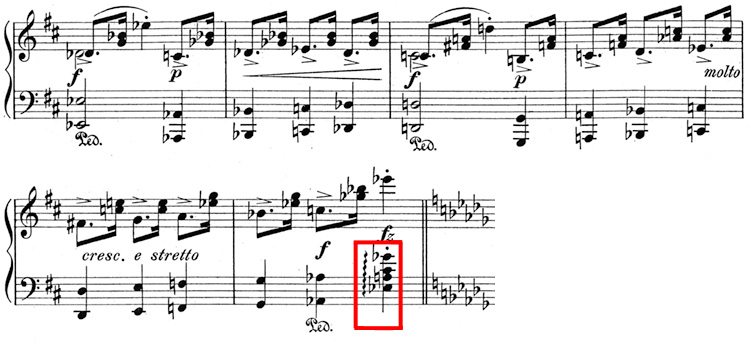
“Entschwundene Tage”, op. 57 no. 1, mm. 65–70
How would you read the red-framed chord in the left hand of m. 70? Upon playing through the piece at the piano I naturally grasped it as e flat/a/c1/g flat1, thus, an unsuspicious diminished chord. However, in fact, it is something else there, because the overall key signature with two sharps makes the c into a c sharp … That results in a bold dissonant chord, though somewhat familiar – and the sound e flat/a/c sharp1/g flat1 actually corresponds precisely to the famous Tristan chord (up a second in the original, notated as f/b/d sharp1/g sharp1). Has the Norwegian master hidden here a little allusion to Wagner? Tristan at Troldhaugen, an attractive idea – but arguing against it is the fact that the c sharp is already consistently resolved to c from m. 65, and Grieg would certainly have clarified such an unusual dissonance with a sharp sign.
A glance meantime at the autograph brings up yet a third reading: for there is in fact also only a natural sign (and no sharp), though not very clearly notated by Grieg just between the 2nd and 3rd notes of the chord:
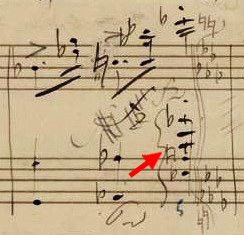
Autograph, Bergen, Offentlige Bibliotek [Public Library]
So, it is also conceivable that meant is actually the chord e flat/a flat/c1/g flat1 – and therefore a “simple” dominant-seventh chord on A flat that would also fit very well with the following section in D flat major.
What do you think – which of the three variants did Grieg probably have in mind? Please write us your opinion in the commentary!

There is yet another solution for this chord. When I first looked at it it felt like a diminished chord. The natural in the autograph between the second and third notes of the L.H. could belong to the note a, thus cancelling out the previous a flat.
The third note would be c if one takes the fact that it is natural from all recent iterations.
So the chord would read:
e flat/a/c/g flat ( a diminished chord)
rather than A flat7 second inversion.
I enjoy your posts!
Thank you for your reply!
But wouldn’t your solution be the same as my first version..?
Dear Dominik Rahmer,
In my humble opinion, Grieg must have meant for the natural sign to apply to the C (sharp) in the chord, not the A-flat, making the chord an A-flat dominant seventh in second inversion. It certainly appears to be closer to the C than the A in the autograph to me.
It comes down to a matter of spelling, as Grieg was a meticulous composer. It would make most sense for the chord to be a dominant seventh which then resolves to D-flat major in the next bar. If it were an A diminished seventh in second inversion, it would be very odd for it to resolve to a root position D-flat major chord with its inversion and spelling. If he intended to write such a chord, I believe he would have resolved it to a B-flat minor triad in first inversion instead to follow the rules of chromatic voice leading. I also notice that Grieg wanted the pianist to depress the pedal on the A-flat left hand octave in the previous beat, so the presence of an A-natural in the next chord would create a strong dissonance with the previous A-flat.
If Grieg intended to slip in a Tristan chord there, he certainly doesn’t spell it the same way as Wagner – he wrote a G-flat instead of F-sharp, eliminating the Tristan chord’s distinctive perfect 4th. If he intended to write a half-diminished seventh chord, the Tristan chord’s enharmonic equivalent, then he used an extremely odd spelling. The half diminished seventh using E-flat, A, C-sharp, and G-flat would usually be written as E-flat/ G-flat/B-double flat/D-flat, or some enharmonic equivalent with D# as a bass note. Either of these would not resolve to a D-flat major triad anyways!
All of these things make me believe that Grieg intended for the chord to be a dominant seventh in second inversion. However, I find it very amusing that this much disputed mystery chord leads into a D-flat major section marked piu lento that lasts for no more than two measures before the music abruptly halts on a fermata… And then unceremoniously switches back to D major in a Beethoven style fake out! 🙂
I really enjoy your posts, and I wish you the best of luck in your work! This blog really is a wonderful place, and I’m glad that I found it today.
Sincerely,
Jeffrey
Thank you for your thoughtful response! In our new edition, we’ve ultimately kept the reading of the first edition, but with a footnote pointing out that Grieg may indeed have intended an A-flat dominant seventh chord.
I also think that the second inversion of A-flat seventh is the correct reading as far as the autograph is concerned.
It is interesting to see that there was originally no modulation. The music originally continued in D major, but at a certain moment, Grieg changed his mind and inserted a double bar line and accidentals (and revised/inserted several accidentals in the preceding measures), in order to arrive D-flat major. Naturals above and below the system suggest that there was not enough room for them, which also underlines my hypothesis. As far as the original chords before the bar line is concerned, they were originally A7 and the composer’s intention should be to transpose them a semitone lower.
Of course, it is a different question what the composer might have accepted/overlooked during proofreading… (And I understand this is the reason why it is an acceptable decision to retain the original notation from the first publication)